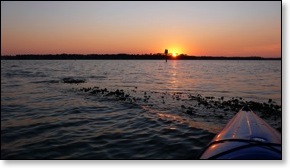
It was in October of 2006 when I first got to dip my kayak paddle into the White Oak. From the first moment that I was on the river I realized that I was someplace special which needed to be preserved.
Without a doubt the White Oak River is one of the crown jewels of the Crystal Coast.
Local history tells us that the Woodland Indians among others have been in the area for over 2,000 years. It is likely they traveled from the mainland to local islands using dugout canoes.
There is archaeological evidence that Huggins Island was used as a place for hunting and fishing for centuries before Theophilus Weeks, the founder of Swansboro, reached the area in 1730.
That being the case, it is almost certain that the Indian dugouts were the first boats to use the White Oak. It wasn't until around 1750 that most of the Indians had left the area for New York.
By then that first permanent colonial settlement, which was created on the site of an abandoned Algonquin Indian village, was well on its way to being a success. In 1783 “Swannsborough” was incorporated.
Most area students can tell you of pirates operating in the area and of Ottaway Burns and the Snapdragon which sailed during the war of 1812. I suspect a few of their ships ventured up the river.
We know the area thrived as a shipbuilding center until the civil war. I can imagine much of the shipbuilding timbers were floated down the White Oak River. While old logging methods were much less damaging to the environment, the impact on the White Oak over time of having most of the large trees cut would have been substantial.
Still with all the marshes in place it is likely that man's first impact on the river was minimal compared to what we see today.
The construction of the Intracoastal Waterway in 1930-32 and Highway 24 in 1933 were the first large assaults by man on the White Oak River. There is evidence that these two projects obstructed up to 80% of the river.
We all know today that moving storm water quickly to the river is one of the worst offenders in declining water quality. Storm water which moves untreated into a river which has become obstructed and cannot flush itself is a both a recipe for trouble and a call to action.
Historically the White Oak River Basin had 458,297 acres of wetlands. The May 2007 White Oak River Basinwide Water Quality Plan indicates that we still have 60% of our original wetlands in nearly the same condition as they were before colonists came to the area.
The same study showed that urbanization now claims much more of our land than it in 1980. We cannot afford to lose additional wetlands if we are going to keep the White Oak healthy and to even improve it's water quality.
While development along the White Oak continues, concern for the river has grown even more.
In 2004, efforts by the N.C. Coastal Federation and the N.C. Coastal Land Trust, helped by money from the N.C. Clean Water Management Trust Fund & the U.S. Fish & Wildlife Service, led to the purchase the Quaternary tract, 1,443 acres bordering the White Oak in Onslow County.
Recent efforts to help the White Oak River have included cleaning up after hurricanes, a pervious parking lot and raingardens in Swansboro. Water samples are currently being collected to track down pollution. A number of groups are working to raise awareness of issues impacting the river.
As the region around the White Oak has paralleled the struggle of other commercial fishing areas in North Carolina, it has remained the home of a valuable sport fishery and some commercial fishing.
As we go forward with efforts to help the White Oak, I can only hope the future of the river is even brighter than it's honorable past.
The Dec. 2004 press release on the Quaternary tract describes the White Oak better than I can. It is a description, I will have in my mind each time I dip a paddle in the water or ride a boat across the wide expanse of the White Oak.
“The 48-mile-long White Oak is one of the last relatively unblemished watery jewels of the N.C. coastal plan. Starting as a trickle in the Hoffman State Forest in Jones County, the predominantly blackwater river lumbers through Jones, Carteret and Onslow counties, gradually widening as it flows past Swansboro and into the Atlantic Ocean. It drains almost 12,000 acres of estuaries – saltwater marshes lined with cordgrass, narrow and meandering hardwood swamps, and rare stands of red cedar that are flooded with wind tides.”
David Sobotta works for WideOpen Networks and is a Writer, Photographer, and Fisherman who can regularly be found on the White Oak either in his kayak or skiff.